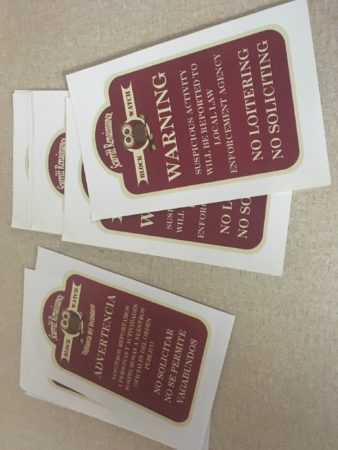Paul Thompson
Northeast News
It’s happened again.
That all too familiar pop-pop-pop of gunfire, followed shortly thereafter by the wailing sirens and flashing lights that accompany a typical law enforcement response. When violent crime targets your neighborhood, it’s easy to feel a sense of despair; to throw your hands up in the air. It takes a little bit more to say enough is enough.
Throughout the Historic Northeast, neighborhood leaders are doing just that. For Indian Mound resident Amanda Wilson, the decision to get more active in her neighborhood’s block watch was sparked after a shooting just down the block from her home.
“There was a shooting six houses down from me in January,” Wilson said. “No one was killed, thank goodness, but sometimes it just takes it hitting really close to home for people to get active. It was definitely shocking.”
Scarritt Renaissance resident Heather Welch was recently named as the neighborhood’s Block Watch Network Coordinator, and she recently started a Scarritt Crime Watch Facebook page with the approval of the neighborhood’s board. Welch says that a major inflection point in the area occurred in mid-October, when homicides were recorded on three consecutive days in the Northeast.
“I think it exploded when we had that weekend of homicides. Immediately, everybody freaked out, and meetings were set,” Welch said. “It just became imperative that we get this organization going faster. I think that was the impetus for getting the (Facebook) group set up, calls for more block captains have gone out, so much more information is organized and ready to be distributed.”

Welch added that she’s not particularly comfortable stepping into a leadership role, but after seeing how hard some of her neighbors were working to make their community better, she couldn’t help but follow suit. She hopes that her own advocacy can help others join the fray, as well.
“Once you get to know these people, and you realize how active and passionate they are, and how hard they’re working, it’s hard not to get involved,” said Welch. “Obviously I’m not a good spokesperson, but if you need an Excel spreadsheet, I can crunch some data for you. Sometimes we just need to ask personally.”
These days, many interactions between neighbors take place on social media. On Scarritt’s block watch page, Welch posts safety tips, crime prevention articles, and perhaps most importantly, links for neighbors who aren’t sure what resources are available to them.
“Here’s some phone numbers,” said Welch, scrolling through a list of resources. “911, the non-emergency number, the administrative number, who our community interaction officer is, who are our commanders for each of the shifts, what other services can be initiated with KCPD on your own.”
In Indian Mound, the crime watch Facebook page has roughly 500 members, some of whom are active on a daily basis. In addition, more narrowly-focused private message threads have been created for neighbors from ‘hotspot’ blocks to share vital information – whether it’s after a violent crime, or as part of ongoing efforts to prevent such an incident.
“It’s to get more private information and to help the neighborhood association identify if there are issues with a particular house, what those issues are, or to just gather better intel,” Wilson said of the private chats. “It’s mostly been information sharing.”
Welch says that she has ‘quite a bit’ of personal interaction with neighbors who don’t feel comfortable posting crime-related observations on social media platforms like Facebook.
“I had one just today that was related to that,” Welch said last week. “She just didn’t want her name out there, didn’t want to be associated with police, didn’t want neighbors to know that she had seen what she had seen. That happens a lot.”
Other neighborhoods in the area rely less upon social media than others. Mark Morales, president of the Sheffield Neighborhood Association, says that his neighborhood utilizes a phone bank to report potential criminal activity. Still, he’d like to see his neighbors get even more active.
“We’ve got 12 phone numbers on our block, and there’s probably 25 residents that utilize the phone bank,” Morales said. “But it’s still not enough within the Sheffield neighborhood. We do want to increase it.”
One area where Morales thinks Sheffield can get more proactive is by installing more video cameras at vital intersections.
“I think we ought to incorporate cameras on the primary or secondary arterial roads in the neighborhood, where if there’s some inappropriate activity happening, we can catch them on the busier streets,” Morales said. “We may not see the crime where it happens, but we’ll know, for example, that the car was in the area at a certain time.”
Independence Plaza Neighborhood Council Secretary Laura Remy agrees that a connected camera system could benefit her neighborhood. She added that Independence Plaza encourages residents to call 911 directly whenever they see or hear suspicious activity.
“We want to promote people to sign up to share their cameras with KCPD,” Remy said. “We also want to get more cameras in public spaces. We don’t know what that’s going to look like, but that’s our goal: to figure out what it looks like and how to do it, and to find a person to facilitate it.”
In Independence Plaza, a few dozen neighbors communicate through NextDoor, a private neighborhood social network. When information passed through Nextdoor needs to be distributed widely throughout the neighborhood, Independence Plaza leaders do so through an email list that includes roughly 120 people.
A goal for both Indian Mound and Scarritt Renaissance is to beef up the block watch outside of social media. Goals include canvassing the neighborhood and recruiting for Block Watch members. Wilson would like to see Indian Mound come up with more ways to assist neighbors with the trauma that follows violent incidents.
“That’s something that I would like our neighborhood to do more of, is some of the victim outreach and advocacy,” Wilson said. “Even if it’s not a person directly affected, but for the houses around where there’s been a shooting, there has to be some sort of trauma that people have experienced.”
Both Indian Mound and Scarritt Renaissance reported success stories through their block watch programs. In Indian Mound, Wilson recalled a recurring issue surrounding a string of houses owned by the same landlord. There had been multiple shootings around the houses, including one homicide. To combat the issues, one long-time resident brought a translator to neighbors around the area and asked for details about the problem homes. Indian Mound leaders followed up with the landlord, informed her of the problem, and worked with the police department to establish grounds for an eviction. The department assisted by providing a list of the repeated calls for service at the addresses.
“With that, she was able to evict them,” Wilson said. “Since then, as far as we know, that block has been quiet. I think that’s a really great success story, and that happened over the course of maybe a month and a half.”
Welch has her own success story, about a block watch captain who had reported a shots fired incident right in front of her home. The issue had been building up over a matter of months, to the point where the captain had managed to identify a suspicious vehicle potentially related to the gunfire.
“This captain decided to map out all the neighbors she knew closest to her and speak to them, to see if they happened to know what was going on,” Welch said.
Together, the concerned residents were able to identify a vacant house they suspected was a hub for drug dealers.
“With this information, KCPD was able to go in and take a look at the place, find out there were squatters in there, and find out that these squatters were some really dangerous people,” Welch said. “They were able to make some arrests, board up the house, and then they watched that house for a long time to make sure it didn’t reoccur. Following that, they had far less incidents of shots fired.”
The success has galvanized Welch to push even further with the block watch program. She has proposed instituting regular group dog walks, trash pick-up days, bike rides, service projects, and regular interactions with neighbors. Anything, she says, to make her neighborhood a safer place to live.
“I’m not forcing anybody to do it; just have your eye on your community,” Welch said. “I’m not a super social person, and I’m not one to go knock on doors, but I will. I mean, isn’t it worth it to get a little out of your comfort zone to make our neighborhood safer?”
She pauses for a moment before finishing her thought.
“This really isn’t natural for me at all, and yet, who else is going to do it?”


















